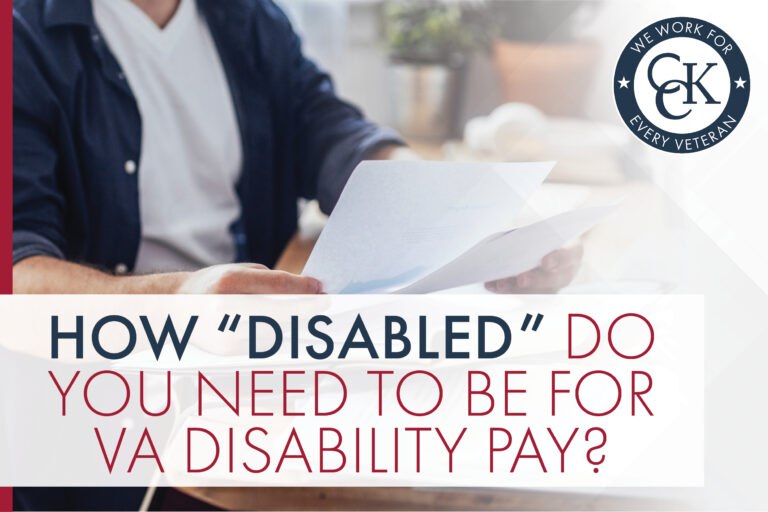How “Disabled” Do You Need to Be for VA Disability Pay?

CCK Law: Our Vital Role in Veterans Law
For many veterans, there is a lot of confusion and misinformation online about how “disabled” one needs to be to qualify for disability from the Department of Veterans Affairs (VA). One persistent myth even claims that only severely disabled veterans—those with amputations, paralysis, or who are wheelchair bound—are eligible for benefits. Myths like these can discourage veterans from applying for the compensation they have earned by law.
Veterans across the disability spectrum qualify for VA benefits, even if:
- They are working full-time
- Their condition is not visible
- They were not diagnosed until after service
- They did not seek treatment during their service
This article will also address these and some of the other common misconceptions that result in veterans self-denying benefits that they have earned through service.
What Are Disability Ratings? Why Does the VA Disability System Exist?
Fundamentally, VA disability ratings exist to compensate veterans for disorders and disabilities that were caused or worsened by their military service, resulting in making it harder to find meaningful employment as civilians. It is part of VA’s duty to compensate these veterans to lessen the financial struggles they may face due to these service-connected conditions.
How Disability Ratings Work
How disability ratings work is by compensating disabled veterans based on the average impairment in earning capacity resulting from the given disability or disease and its residual conditions.
Essentially, this means that VA assigns disability ratings—and sends veterans a corresponding dollar amount each month, as well as other benefits like retraining and health care—based on how severely a veteran is disabled.
For each condition found to be service connected, veterans get an assigned rating that represents the severity of their condition. The ratings range from 0 to 100 percent, in multiples of 10 (e.g., 0 percent, 10 percent, 20 percent, 30 percent, and so on). Veterans receive greater amounts of compensation for higher disability ratings.
For example, a 0 percent rating means the condition is service connected, but not severe enough for the veteran to receive monthly compensation. On the other hand, a 100 percent rating means VA will issue the maximum amount of standard compensation that they offer.
Currently, dollar amounts for compensation range from $0 to over $3,600 per month.
Can a 100 Percent Disabled Veteran Still Work Without Losing Benefits?
Yes, they can. Unlike, for example, workers’ compensation, most VA benefits are not based on actual employment status, but simply the average impairment to earning capacity experienced by a veteran with a certain disability.
When it comes to how disability ratings work, impairment level is based on the “average” veteran, and does not necessarily mean that you need to be completely disabled to receive a 100 percent rating.
One exception is for veterans who receive 100 percent benefits through Total Disability based on Individual Unemployability (TDIU), since TDIU is reserved specifically for veterans who—by definition—cannot work, even if their actual VA rating may not technically be 100 percent.

VA’s Schedule of Ratings
If VA determines that a veteran’s condition is related to their military service, then they will proceed to rate the veteran’s condition depending on symptom severity, frequency, and overall impact on health (and thus earning capacity).
For this process, VA uses a framework called the Schedule of Rating Disabilities (or Ratings Schedule) to determine how serious a veteran’s disability is, and therefore how much compensation they are entitled to.
Within the Ratings Schedule exist diagnostic codes for the most common disabilities and disorders that veterans face. Each diagnostic code corresponds to a specific disorder and includes rating criteria so that VA experts can judge a veteran’s symptom severity and functional limitation.
Examples of a few diagnostic codes include:
- Diagnostic code 8100 – Migraine Disorder – Veterans with migraine disorder can receive the following ratings for their condition based on symptom severity and frequency:
- 50 percent – Very frequent, completely prostrating and prolonged attacks, productive of severe economic inadaptability
- 30 percent – Characteristic prostrating attacks occurring on an average of once a month over the last several months
- 10 percent – Characteristic prostrating attacks averaging one in two months over the last several months
- 0 percent – Less frequent attacks
- Diagnostic code 9411 – post-traumatic stress disorder (PTSD) – Veterans with PTSD can receive the following ratings for their condition based on symptom severity and frequency:
- 100 percent – Total occupational and social impairment
- 70 percent – Occupational and social impairment, with deficiencies in most areas, such as work, school, family relations, judgment, thinking, or mood
- 50 percent – Occupational and social impairment with reduced reliability and productivity
- 30 percent – Occupational and social impairment with occasional decrease in work efficiency and intermittent periods of inability to perform occupational tasks
- 10 percent – Occupational and social impairment due to mild or transient symptoms
- 0 percent – A mental condition has been formally diagnosed, but symptoms are not severe enough either to interfere with occupational and social functioning or to require continuous medication
The Ratings Schedule also helps ensure consistency across VA decisions, since every veteran is rated using the same general collection of codes and criteria.
How Does VA Combine Ratings?
If a veteran has multiple service-connected disabilities, VA does not simply add each of the veteran’s rating percentages together. Instead, they use something called the “whole person theory” or “VA math” to calculate that veteran’s total disability rating.
For instance, say a veteran possesses a 50 percent rating for migraine disorder as well as a 30 percent rating for PTSD. Using VA math, these ratings will actually combine into a 65 percent rating, which VA then automatically rounds up to the next multiple of 10. This results in the veteran being assigned a combined rating of 70 percent.
VA uses the whole person concept for multiple reasons:
- For one, it reflects the reality that each additional condition a veteran is diagnosed with has a smaller economic impact on their life than their “primary” condition.
- Secondly, it helps ensure that veterans do not receive a combined rating greater than 100 percent, since it is not possible to be more than 100 percent disabled.

Other Common Misconceptions That Turn Veterans Away
There are many common misconceptions veterans have about VA disability that may discourage them from applying—even if the veteran actually qualifies for benefits. Some of these include:
- “I didn’t seek treatment during service, so I can’t file now.” – This is false. Many VA disability claims rely on later medical records and expert opinions to establish service connection.
- “I’m still working, so I must not qualify.” – False. Most veterans with ratings are employed, even full-time.
- “I’m not as bad off as other veterans, so I don’t deserve benefits.” – Compensation is not about how one veteran compares to another, it’s about your service-connected limitations that may qualify you for compensation. It’s also important to note that winning a claim does not take benefits away from others. VA is required to propose budgets that allow compensating every veteran for their service-connected disabilities.
Why Should I Start a VA Disability Claim?
If you are still unsure whether VA will consider your disability claim, this section will guide you through the early decision-making process so you can feel more confident in your choice whether or not to file.
Disabilities Are Unfortunately a Common Result of Service
If any of the following statements are true for you, you should think seriously about filing a claim with VA:
- You experience recurring symptoms tied to service—including pain, fatigue, depression, anxiety, hearing disorders, and more
- You have developed a condition with a known military link—including toxic exposure, blast injuries, repetitive strain, mental trauma, and more
- You are developing new symptoms due to separate conditions that are already service connected. For instance, if you take medication to manage service-connected PTSD, then any side effects of that medication could also be compensable by VA
Some service-connected disorders occur at higher rates among veterans. Think about the following conditions and whether you have experienced symptoms of them before:
- Tinnitus
- Hearing Loss
- Knee pain or injury
- PTSD
- Migraines
- Back pain or injury
- Sciatica
- Ankle pain or injury
- Sleep apnea
- Traumatic brain injury (TBI)
- Depression
- Diabetes
- Cancer

Your Condition Could Worsen
Even if you have a service-connected condition with relatively minor symptoms that you feel you can manage on your own, it is important to consider that symptoms often worsen as you age. Given that the claims process can take years, it is beneficial to establish service connection as soon as possible.
Some service-connected conditions that often appear later in life or worsen with age include:
- Parkinson’s disease
- Heart disease
- PTSD
- COPD
- Chronic bronchitis
- Pulmonary fibrosis
- Arthritis
- Peripheral neuropathy
- Cancer
Ask for Help: Resources and Assistance
There are several tools and resources available to help you in the claims process, including:
- CCK Law’s VA Claim Builder Tool – This easy-to-use tool allows veterans to estimate the compensation they could receive from VA based on their symptoms.
- VA.gov Disability Compensation Portal – This portal serves as the central hub for veterans to submit and manage their VA disability claims.
- Chisholm Chisholm & Kilpatrick (CCK Law) – Use our blog or YouTube channel to research your claim. If you have filed a claim and disagree with a VA decision, consider asking for help. Request a free case evaluation at (800) 544-9144 or online.
About the Author
Share this Post
